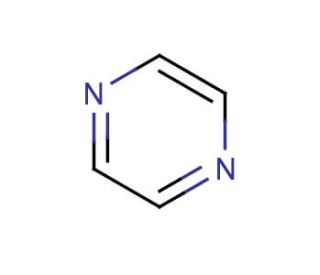

Pyrazine (CAS 290-37-9)
QUICK LINKS
Pyrazine, a simple yet fascinating heterocyclic aromatic compound, is distinguished by its pair of nitrogen atoms directly opposite each other in its six-membered ring structure. This configuration endows pyrazine with unique electronic properties, making it an indispensable scaffold in the synthesis of more complex molecules for various research applications. In the realm of chemical research, pyrazine serves as a key building block in the design and development of molecules with specific electronic characteristics, such as enhanced conductivity or photoluminescence, making it for advancing materials science. Furthermore, its ability to act as a ligand, forming coordination complexes with metals, has been exploited in the synthesis of novel catalysts and in the study of metal-organic frameworks (MOFs), which are of great interest for their potential applications in gas storage, separation technologies, and catalysis. The role of pyrazine in research extends into the exploration of its derivatives for their potential application in the development of new materials and chemicals that exhibit specific, desirable properties, such as thermal stability and electronic conductivity, highlighting its versatility and significance in scientific exploration and innovation.
Pyrazine (CAS 290-37-9) References
- Pyrazine derivatives: a patent review (2008 - present). | Ferreira, SB. and Kaiser, CR. 2012. Expert Opin Ther Pat. 22: 1033-51. PMID: 22860922
- Pyrazine derivatives: a patent review (June 2012 - present). | Dolezal, M. and Zitko, J. 2015. Expert Opin Ther Pat. 25: 33-47. PMID: 25523365
- Alkyl pyrazine synthesis via an open heated bath with variable sugars, ammonia, and various amino acids. | Ara, KM., et al. 2017. J Sci Food Agric. 97: 2263-2270. PMID: 27629531
- Yoda1 analogue (Dooku1) which antagonizes Yoda1-evoked activation of Piezo1 and aortic relaxation. | Evans, EL., et al. 2018. Br J Pharmacol. 175: 1744-1759. PMID: 29498036
- Enzymatic Cascade in Pseudomonas that Produces Pyrazine from α-Amino Acids. | Masuo, S., et al. 2020. Chembiochem. 21: 353-359. PMID: 31322801
- New Pyrazine Conjugates: Synthesis, Computational Studies, and Antiviral Properties against SARS-CoV-2. | Seliem, IA., et al. 2021. ChemMedChem. 16: 3418-3427. PMID: 34352160
- Pyrazine and Phenazine Heterocycles: Platforms for Total Synthesis and Drug Discovery. | Huigens, RW., et al. 2022. Molecules. 27: PMID: 35164376
- Low-Molecular Pyrazine-Based DNA Binders: Physicochemical and Antimicrobial Properties. | Mech-Warda, P., et al. 2022. Molecules. 27: PMID: 35744829
- Structural Sampling and Solvation Models for the Simulation of Electronic Spectra: Pyrazine as a Case Study. | Tsuru, S., et al. 2023. J Chem Theory Comput. 19: 2291-2303. PMID: 36971352
- Pharmacological activity and mechanism of pyrazines. | Hou, W., et al. 2023. Eur J Med Chem. 258: 115544. PMID: 37300915
- Design and Synthesis of Far-Red to Near-Infrared Chromophores with Pyrazine-Based Boron Complexes. | Takahashi, H., et al. 2023. Chem Asian J. e202300489. PMID: 37365136
- Optimization of Cold Brew Coffee Using Central Composite Design and Its Properties Compared with Hot Brew Coffee. | Zakaria, NH., et al. 2023. Foods. 12: PMID: 37372624
- Introducing Bidirectional Axial Coordination into BiVO4@Metal Phthalocyanine Core-Shell Photoanodes for Efficient Water Oxidation. | Pan, JB., et al. 2023. Angew Chem Int Ed Engl. e202307246. PMID: 37488928
Ordering Information
| Product Name | Catalog # | UNIT | Price | Qty | FAVORITES | |
Pyrazine, 5 g | sc-250805 | 5 g | $22.00 | |||
Pyrazine, 10 g | sc-250805A | 10 g | $36.00 |
